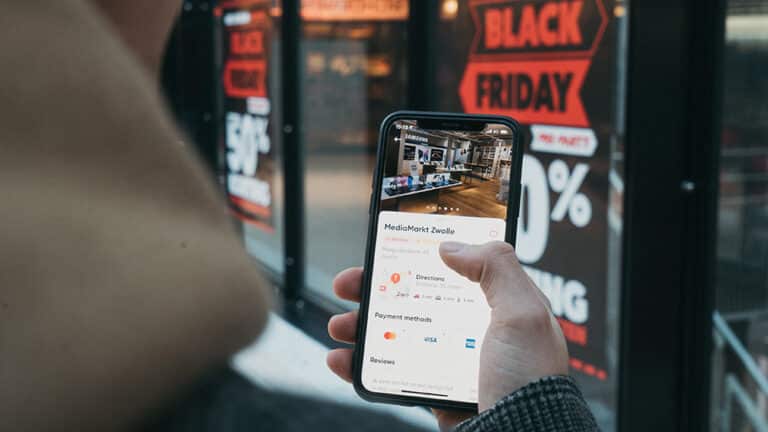Social media is used by more than 53% of the world’s population according to the latest survey by Hootsuite. Snapchat is mainly used by a younger audience and there are great opportunities to advertise to a buying-prone target group as 60% make spontaneous purchases in the app. In this post, we will go into how to get started with your Snapchat advertising.
Snapchat is a social platform where you as a user can share photos and videos with various stickers and filters, make a video call, or chat with other users. The app was launched in 2011 in the United States. Today, the app is used daily by 238 million million Internet users around the world, according to statistics from Hootsuite. The app has active users who on average open the app more than 30 times a day. Snapchat has a young target group compared to other social channels, as many as 82% of all Snapchaters are under 34 years old. According to a Hootsuite survey, 60% of Snapchat users make spontaneous purchases.
Now, let’s dive into how to get started with your Snapchat advertising below.
Get started with advertising on Snapchat
To get started with your Snapchat advertising, you need to set up a business account, and to access Snapchat’s advertising tool: Snap Ads Manager. Once you have reached the stage of creating your ad, you need to set an objective, depending on who you want to reach through your advertising. Then you choose the objective for the campaign; website traffic, installation of apps, brand awareness, etc. To finally, then choose the budget and finally the placement of the ad.
Install a pixel.
To be able to measure your advertising and then be able to retarget to your existing customers, you need to collect data from your current target groups. You can do this through a pixel that you install in Snapchat Ads Manager.
We will delve into details further down in this post.
Strategy – Advertising on Snapchat
Objective
You need a purpose for your advertising to be able to know what objective you should have for your campaign. These are usually based on where in the customer journey you want to reach your target audience.
It is common to start from these three steps, that are part of a classic marketing funnel when choosing a goal:
- Brand awareness
- Consideration
- Conversion
Target groups.
In the choice of audience on Snapchat’s advertising platform, you can, like other channels, target your audience through demographics, interests and habits. A tip is to create a persona according to the target group you have today, and then find out who you want to reach with your advertising. This step is the most important thing for you to succeed with your advertising – because if you do not reach the right people with your campaigns, your advertising will not be profitable.
Content.
Via Snapchat, you can use creative content and what is mainly trending is movable content as video. What you should keep in mind is that the content needs to be mobile-adapted to work in the app.
Step by step – Advertising on Snapchat
In Snapchat Ads Manager, you get started with your advertising and here’s how to proceed step by step.
Step 1 – Choose an objective
As previously mentioned, you need to set an objective for your campaign before you get started. In Snapchat Ads Manager, you can choose between these goals:
Brand awareness:
- Build brand awareness
- Introduce potential customers to your brand
- Showcase new products or services to existing customers or potential customer
Conciderations:
- App installations
- Website traffic
- Traffic to the App
- Engagement
- Video views
- Lead Generations
Conversions:
- Conversions on the website
- Catalog / Sales
Step 2 – Budget
You can choose to set a daily budget or lifetime budget. Once you have set your goal, your cost in your advertising is based on a goal-based bidding. This is to be able to optimize your ads. There are three types of bidding strategies:
Automatic bidding – Allows Snapchat to distribute your budget to get as many interactions from the target audience as possible.
Maximum bid – is the maximum budget that Snapchat can spend to get as cost-effective CPA as possible
Step 3 – Format
In Snapchat Ads Manager you can choose between these formats:
Single image or video – Here you can drive the target group via your image or video to your website, app, video, AR Lins, or App store by having them sweep up your ad.
Story Ad – A collection of 3-20 images that come up in your target group’s “discover-feed”
Collection Ad – A collection of images of products that drive traffic to the website.
AR Lens – A lens that you create yourself through Snapchat Lens studio.
Sponsored filter – You can create your own filter with a graphic element with your message that can be applied to your target group’s Snapchat video or image.
Dynamic Ads – Dynamic ads are a way to reach already varm audiences, and to personalize an ad by targeting a product that your audience has previously reviewed, you can increase the chance of conversion.
Step 4 – Target group
Once you have chosen your format, it’s time to choose your target audience. There are four options to choose from when it comes to segmenting your audiences. You can also choose to expand your target audience with “Expand audience Automatically” for maximum reach.
Lifestyle – Relevant target group based on what your target group has previously interacted with, and consists of subcategories based on interests.
Shoppers – Target group based on what people buy in shops, restaurants, arenas and retailers.
Viewers – Target audience based on what they previously watched for TV, film and video.
Visitors – Target group based on the places they visit during the day such as restaurants, shops, entertainment activities, etc.
Step 5 – Measure advertising
Once you have installed a pixel, you can measure how your ads are performing in order to optimize them against your previously set campaign objective. The most common are then setting up specific metrics (KPIs).
Here are some of the most common KPIs:
Impressions – How many unique impressions does your ad have?
Completion Rate – How many people see your entire video ad on Snapchat story?
Screenshots – How many people take a screenshot of your ad?
Cost per click – How much does each sweep up on your ad?
Cost per mille- What is your cost per 1000 impressions?
Swipe Ups – The number of times the ad has registered that a user has made an upward swipe.
Through these KPIs, you can keep track of whether your campaign achieves the goal you are striving for and optimize your ads during the campaign period.
A/B testing
Same as advertising on Facebook, you can create an A / B test to see what your target audience interacts and is engaged by. You do this by creating two ads that are similar to each other, but you change small details that can be color, copy, language, etc. Then you can evaluate what attracts your audience and optimize your ads.
Summary.
As with all social media advertising, it takes time to achieve results. It is important to analyze your target group and make sure that you reach the right audience. It’s the most important thing otherwise it doesn’t matter how graphically good looking your ads are or how important your message is. So focus on understanding your target audience and do an A / B test on your ads. There is no conclusion, only guidelines on how to proceed. Try things out, learn by doing and OPTIMIZE more!
Hope you enjoyed the article. Don’t forget to stay updated by subscribing to our newsletter!





